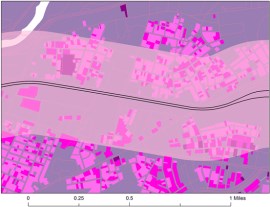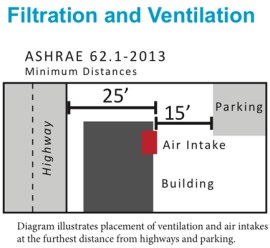
by Jim Newman — Design and construction techniques that focus on enhancing human health are a hot new topic for practitioners. There is an new initiative for healthy communities at the Urban Land Institute (ULI), a new track at the Greenbuild conference on healthy building products, and new programs at many universities that are focused on health and the built environment. Protecting people from the negative health effects of pollution from highway traffic is one small part of this puzzle.
It is well established that people living near highways and major roadways are more likely to experience a range of adverse cardiovascular and respiratory health problems. This evidence is based on a large number of studies. The evidence shows significantly elevated cardiovascular mortality risk, lung cancer and childhood asthma in exposed locations. Emerging studies also show elevated risk of autism. To quote Doug Brugge, Professor of Public Health at Tufts University, “The correlation between fine particulate pollution and mortality is well established, and the US EPA regulates levels accordingly. However, health threats are also posed by much smaller particulate pollutants, ultrafine particles”.
It is likely that people living and working near highways are at risk of health problems caused by exposure to elevated levels of traffic-related air pollution. We also know that there are ways to reduce the health risks for people.
Building For Health
There are several important ways to mitigate the health effects of pollution from highways, ranging from keeping buildings at least 700 feet away from highways to the careful placement of air intakes that feed building ventilation systems.
A 700 Foot Buffer Around Highways
The easiest and most effective way to reduce exposure of people to pollution from highways is to site residences, schools, parks, and other sensitive uses more that 700 feet from highways. This can be done by leaving open space around highways or by siting less sensitive building uses within this buffer zone. This generally must be done on a large scale or campus setting, where it is possible to control the placement of a large number of buildings.
The concentrations of ultra fine particulate pollution drops of significantly further than 700 feet from a highway. While this drop in concentrations is due to many factors, the 700 foot buffer is a pretty easy and reliable way to avoid human exposure to pollutants.
Building Air Filtration
Indoor air filtration works well for improving indoor air quality. Filters for residences and schools near busy roadways should probably be Minimum Efficiency Reporting Value (MERV) 14 or above, because filters with lower MERV ratings are not as effective at removing ultra fine particles. Although existing standards for filters vary quite a bit, a higher MERV rating is generally better. Filters used for air pollution reduction should be carefully maintained.
Air Intake Location
To further reduce exposure to air pollution inside buildings, building air intake locations should be placed both vertically and horizontally as far from traffic as possible. Ideally, air intakes should be placed on the side or back of the building relative to the highway. Indoor air pollution reductions of ~50% can be achieved with relatively little expense during building construction, having a large impact on indoor air quality.

Further resources for understanding health effects of pollution from highways can be found at:
Tufts University CAFEH Project
http://sites.tufts.edu/cafeh/
California Air Resources Board research
http://www.arb.ca.gov/research/research-results.php?category=Health%20Exposure
The Well Building Rating System
http://delos.com/about/well-building-standard/